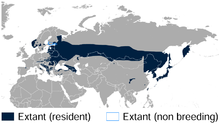White-backed woodpecker
(Redirected from
Picoides leucotos
)
| White-backed woodpecker | |
|---|---|

| |
| Male | |

| |
| Female | |
| Scientific classification | |
| Domain: | Eukaryota |
| Kingdom: | Animalia |
| Phylum: | Chordata |
| Class: | Aves |
| Order: | Piciformes |
| Family: | Picidae |
| Genus: | Dendrocopos |
| Species: | D. leucotos
|
| Binomial name | |
| Dendrocopos leucotos (Bechstein, 1802)
| |

| |
| White-backed Woodpecker range[2] | |

| |
| White-backed Woodpecker range in Europe and western Asia[2] | |
The white-backed woodpecker (Dendrocopos leucotos) is a Eurasian woodpecker belonging to the genus Dendrocopos.
Taxonomy
The white-backed woodpecker was
type locality is Silesia, a historical region mainly located in Poland.[5] The species is now placed in the genus Dendrocopos that was introduced by the German naturalist Carl Ludwig Koch in 1816.[6][7]
Twelve subspecies are recognised.[7]
- D. l. leucotos (Bechstein, 1802) – widespread across Eurasia from north, central and eastern Europe to northeast Asia, Korea and Sakhalin
- D. l. uralensis (Malherbe, 1860) – west Ural Mountains to Lake Baikal
- D. l. lilfordi (Sharpe & Dresser, 1871) – Pyrenees to Asia Minor, Caucasus and Transcaucasia
- D. l. tangi Cheng, 1956 – Sichuan province, western China
- D. l. subcirris (Stejneger, 1886) – Hokkaido, northern Japan
- D. l. stejnegeri (Honshū, Japan
- D. l. namiyei (Stejneger, 1886) – south Honshū, Kyushu, Shikoku (Japan)
- D. l. takahashii (Kuroda & Mori, 1920) – Ulleungdo Island (off eastern Korea)
- D. l. quelpartensis (Kuroda & Mori, 1918) – Jeju Island (off South Korea)
- D. l. owstoni (Ogawa, 1905) – Amami Ōshima Island in the northern Ryukyu Islands, Japan
- D. l. fohkiensis (Buturlin, 1908) – mountains of Fujian province, southeast China
- D. l. insularis (Gould, 1863) – Taiwan
The subspecies D. l. owstoni is sometimes considered a distinct species, the Amami woodpecker.[8]
Description
It is the largest of the spotted woodpeckers in the
western Palearctic, 24–26 cm long with wing-span 38–40 cm. The plumage is similar to the great spotted woodpecker, but with white bars across the wings rather than spots, and a white lower back. The male has a red crown, the female a black one.[9]
Drumming by males is very loud, calls include a soft kiuk and a longer kweek.
Distribution
The nominate race D. l. leucotos occurs in central and northern
Biodiversity Action Plan.[10]
Ecology
In the breeding season it excavates a nest hole about 7 cm wide and 30 cm deep in a decaying tree trunk. It lays three to five white
eggs and incubates for 10–11 days. It lives predominantly on wood-boring beetles as well as their larvae, as well as other insects
, nuts, seeds and berries.
Life Span
In the wild the white-backed Woodpecker (Dendrocopos leucotos) can survive between three and four years, while in captivity they can survive for approximately eleven years.[11]
References
- . Retrieved 12 November 2021.
- ^ a b BirdLife International and NatureServe (2014) Bird Species Distribution Maps of the World. 2014. Dendrocopos leucotos. In: IUCN 2014. The IUCN Red List of Threatened Species. Version 2014.3. http://www.iucnredlist.org. Downloaded on 27 May 2015.
- ^ Bechstein, Johann Matthäus (1802). Ornithologisches Taschenbuch von und für Deutschland, oder, Kurze Beschreibung aller Vögel Deutschlands für Liebhaber dieses Theils der Naturgeschichte (in German). Leipzig: Carl Friedrich Enoch Richter. p. 66.
- ISBN 978-1-4081-2501-4.
- ^ Peters, James Lee, ed. (1948). Check-List of Birds of the World. Vol. 6. Cambridge, Massachusetts: Harvard University Press. p. 189.
- ^ Koch, C.L. (1816). System der baierischen Zoologie (in German). Vol. 1. Nürnberg: Stein. pp. xxvii, 72.
- ^ Rasmussen, Pamela, eds. (2020). "Woodpeckers". IOC World Bird List Version 10.1. International Ornithologists' Union. Retrieved 28 May 2020.
- . Retrieved 15 May 2020.
- ISBN 0-19-854099-X.
- ^ National Biodiversity Action Plan of Sweden, Upsala (1999)
- ISBN 0198575076.
Further reading
- Gorman, Gerard (2004): Woodpeckers of Europe: A Study of the European Picidae. Bruce Coleman, UK. ISBN 1-872842-05-4.

